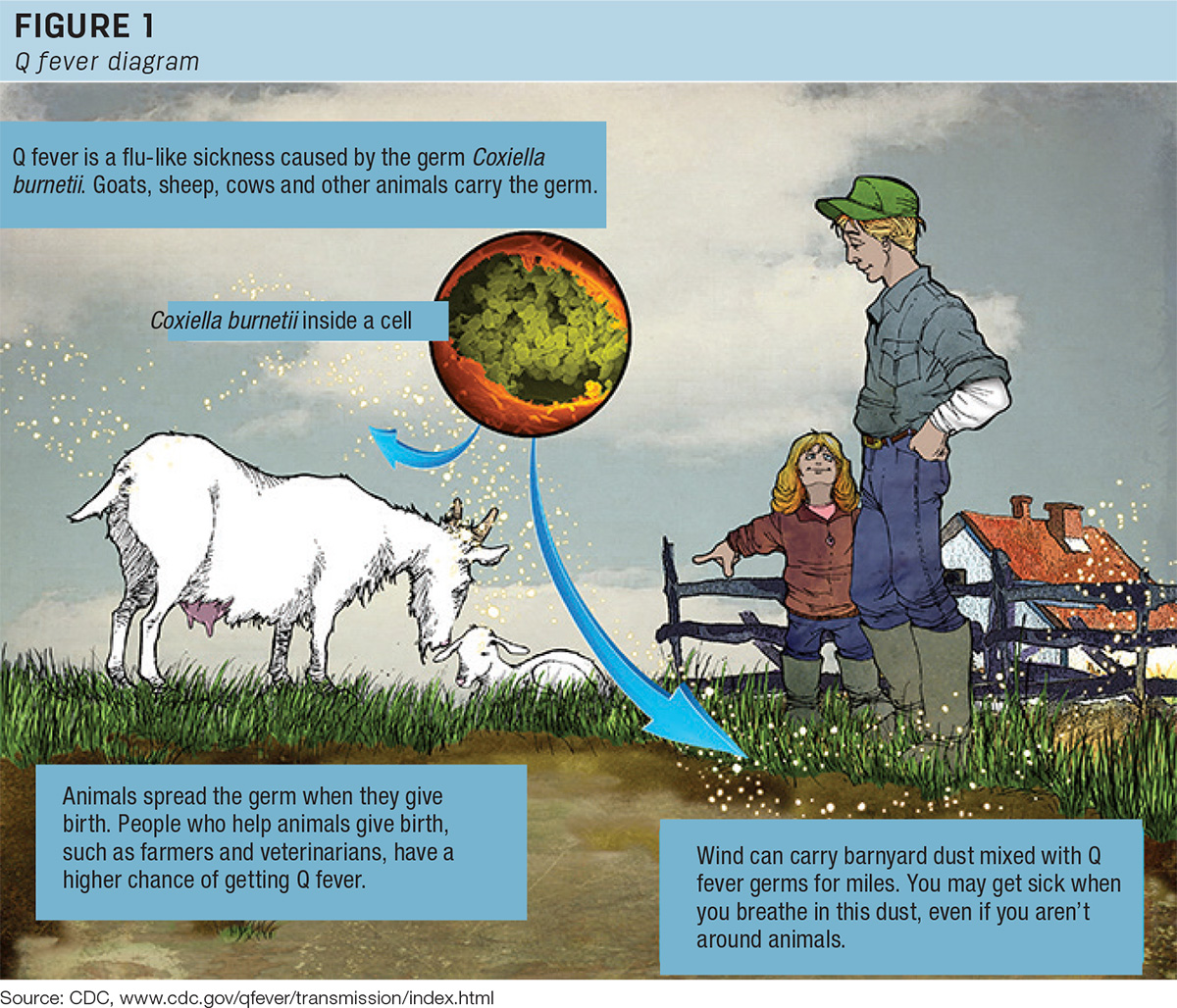There are an increasing number of women in the agricultural space. According to the 2017 census, 1.2 million women identify as agricultural producers, up 27% from the 2012 census.
Knesha Rose-Davison, public health program director for AgriSafe Network, dove deeper into the subject of zoonotic disease in a recent webinar.
Pregnancy-related risks are among the top three health and safety issues for women in agriculture, according to the National Institute for Occupational Safety and Health – specifically zoonotic diseases. Zoonotic diseases are infections and diseases that can naturally be transmitted between vertebrate animals and humans. The transmission hosts can be bacterial, viral, fungal or parasitic.
Successful pregnancy depends on adaptation of the woman’s immune system to tolerate a genetically foreign fetus. For the pregnancy to thrive and prosper, it requires a weakening of the woman’s immune system. This can leave a pregnant woman susceptible to any number of infectious diseases.
There are four significant zoonotic diseases affecting the ag population today. A fifth is also mentioned, which is the leading cause of death attributed to foodborne illness in the U.S.
Brucellosis (bacterial)
A worldwide reproductive disease
Maternal infection: Can result in miscarriage during first and second trimester or pre-term delivery
Carriers: Goats, sheep, pigs, cattle, dogs
Exposure route: Unpasteurized milk, dairy products or exposure to infected body fluids and tissue of infected animals
Symptoms: Flu-like illness
Treatment: Usually diagnosed, blood tested and treated and prescribed antibiotics by a doctor (doxycycline and rifampin combo for six to eight weeks)
Recovery: Few weeks to several months
Mortality: Death is rare and occurs in no more than 2% of all cases.
Prevention/protection: Do not consume undercooked meat or unpasteurized dairy products.
Chlamydiosis (bacterial)
Can cause respiratory disease eye infections and abortions in animals and sometimes humans
Maternal infection: Pregnant woman who become infected can abort.
Carriers: Sheep and goats are most commonly affected.
Exposure: Most likely to occur from ingestion (unwashed hands after contact with an ill animal), aerosol (contaminated dust or splash from infected animal tissue) or direct contact with mucous membrane (touching your eye with contaminated hands).
Symptoms: Flu-like symptoms
Prevention: Bacteria can be killed with cleaning, disinfection and heat.
Protection: Keep boots clean, don’t walk inside the house, and disinfect pens when animals have birthed or aborted.
Leptospirosis (bacterial)
Bacterial infection (millions of people infected each year)
Carriers: Dogs, rodents, cattle, horses, pigs
Transmission: Urine or blood from an infected animal or damaged skin (common route is for humans getting urine or blood from an infected animal on damaged skin; a tiny skin abrasion is enough for bacteria to get into the body), also enters through mucous membranes (eyes, nose, mouth or genitals). The infected animal is often symptom-free and can continue to excrete bacteria into the air year after year.
Symptoms: High fever, headache, chills, muscle aches, vomiting, jaundice, red eyes, abdominal pain, diarrhea, rash. Infected people can become sick in phases any time between two days and four weeks after exposure. It is often mistaken for other diseases. Some infected persons have no symptoms at all. The first phase is fever, chills, etc. If the second phase develops, more serious symptoms include kidney or liver failure and meningitis.
Treatment: Antibiotics penicillin and doxycycline given in the early course of the disease
Prevention: Infection is greatly reduced by not swimming or wading in water that may be contaminated with animal urine. Flood waters are common areas of exposure.
Protection: Protective clothing or footwear should be worn by those exposed to contaminated water or soil.

Q fever (bacterial)
Maternal infection: Women infected during pregnancy are at risk for miscarriage, stillbirth or low infant birth weight.
Carrier: Goats, sheep, cattle
Transmission: Found in birth products, urine, feces and milk of infected animals
Exposure route: Breathing in dust, feces, urine, milk, birth products
Symptoms: Flu-like symptoms typically develop two to three weeks after exposure.
Treatment: Most people will recover without antibiotic treatment, but treatment with doxycycline antibiotic is recommended for two weeks. Chronic Q fever is life-threatening and requires several months of antibiotic treatment (doxycycline and hydroxychloroquine).
Prevention: Avoid contact with animals giving birth if possible; animals can be infected and not appear sick.
Protection: Don’t consume raw dairy products. If you have a weakened immune system, history of heart valve disease, blood vessel abnormalities or are pregnant, talk to a healthcare provider.
Toxoplasmosis/T. gondii (parasitic)
This is the leading cause of death attributed to foodborne illness in the U.S. More than 40 million men, women and children carry toxoplasma parasites, but very few have symptoms because the immune system keeps parasites from causing illness.
Exposure route: Eating undercooked meat or shellfish, contact with uncooked meat or shellfish, absorbed through the skin, drinking contaminated water, swallowing parasites through coming into contact with cat litter boxes (cats shed toxoplasma in their feces), ingesting contaminated soil on unwashed fruits and vegetables, contact with contaminated feces or mother-to-child transmission
Symptoms: Most people have no symptoms; some have flu-like symptoms that may last for a month or more. Severe toxoplasma can cause damage to the brain, eyes and other organs. Most infants who are infected have no symptoms at birth and develop symptoms later in life. A small percentage of infected newborns have serious eye or brain damage.
Treatment: A blood test may be needed to determine if toxoplasma is present. If no symptoms are present, no treatment is necessary. There are treatments available for pregnant women with symptoms.
Prevention: Cook food to safe temperatures. Peel and wash fruits and veggies; do not consume unpasteurized goat milk; wash hands and utensils.
Protection: Wear gloves when gardening. Change the cat litter box daily; toxoplasma parasite does not become infectious until one to five days after it is shed in cat feces.
The surest way to avoid exposure to any of these diseases as a pregnant woman is to transfer a job or responsibility. However, that may not be a feasible reality for your operation. If the transfer of jobs and assignments is not an option in your work role, there are occupational prevention and protection measures women can take to safeguard against zoonotic diseases.
Occupational prevention/protection measures
- People who handle animal tissue should protect themselves by wearing rubber gloves, goggles, gowns or aprons.
- Wear eye protection, rubber or latex gloves when working with animals.
- Avoid direct bare-skin contact with fluid or organs from animals.
- Wash hands as soon as possible with warm water and soap.
- Clean all tools and surfaces with a disinfectant.
Remember, a smart practice to be in the habit of is proper hand-washing techniques. That can look as simple as using warm water and soap, and washing for the time it takes to sing “Happy Birthday” twice.







